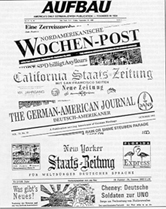|
|
|
 |
|
|
Germans in America > German Language in the U.S. |
|
The Germantown settlers were followed by tens of thousands of other German immigrants during the 18th century. In 1790 roughly 277,000 Americans were of German ancestry. About 141,000 of these lived in Pennsylvania, where they constituted almost one third of the total population. There is a popular legend that German almost became the official language of the United States. This notion has been popularized by German authors of travel literature since the 1840s. According to the so-called "Muhlenberg legend," a vote was taken in the Pennsylvania state parliament sometime in the 1790s on whether German should be the official language. Apparently the Speaker of the House, a German-American by the name of Frederick A. Muhlenberg, cast the decisive vote for English and against German. In reality, this presumed proposition was never brought to the floor and a vote was never taken. The historical origin of this legend might have been a failed attempt in Congress in 1794, based on a petition of German residents of Augusta Co., Virginia, to have "a certain proportion" of the laws of the United States printed in German as well as English. A year later, the petition was denied by Congress by a vote of 42 to 41. German Language Press in the U.S. During World War I, many German-Americans discontinued the use of German to demonstrate their patriotism. Many German newspapers ceased publication. There are to this day, however, still a small number of German language newspapers. The German "Washington Journal" is, for example, the oldest newspaper in the nation's capital. The German Language Today Resident language consultants from Germany, specialized in teaching "German as a Foreign Language," are attached to the education departments of six U.S. states -- California, Georgia, Pennsylvania, Virginia, Washington, and Wisconsin.. Supported by the German government, these experts assist state and regional groups with language program development and standards. The Goethe Institute e.V., a non-governmental organization devoted to teaching German language and culture, maintains 7 cultural centers in the United States. In Germany, some 2,000 Americans attend intensive German language courses through the Goethe Institute. See also: |
||
| Texts
are abridged from U.S. State Department IIP
publications and other U.S. government materials. |
||
| What
kind of information materials are available?
CD: These documents are available in fulltext format on the About the USA CD-ROM. Teachers: Request a copy for classroom use. L: Selected documents are available in German as well as other languages, including Arabic, Chinese, French, Spanish, Persian and Turkish. |
DISCLAIMER
Any reference obtained from this server to a specific commercial product, process, or service does not constitute or imply an endorsement by the United States Government of the product, process, or service, or its producer or provider. The views and opinions expressed in any referenced document do not necessarily state or reflect those of the United States Government. |
 U.S. Diplomatic Mission to Germany /Public Affairs/ Information Resource Centers Updated: December 2008 |
